ASUS ROG Strix G15 G513R (2022) review – new Ryzen CPUs and even more raw power
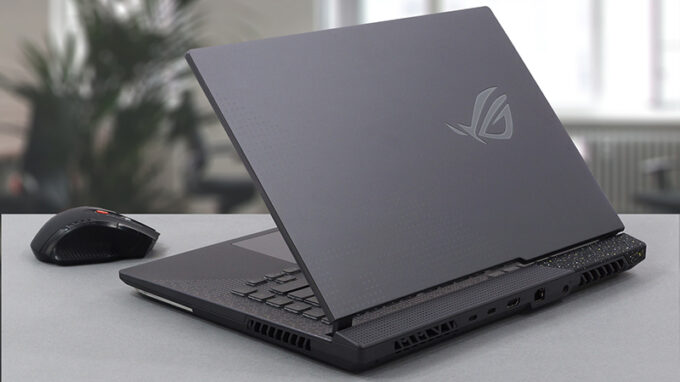 Last year, the ROG Strix G15 G513 was one of the best gaming laptops in terms of value. You got an amazing amount of performance, without draining your bank account at the same time. Well, now, we have the refresh of this same notebook, which is credibly named the ROG Strix G15 G513R.
Last year, the ROG Strix G15 G513 was one of the best gaming laptops in terms of value. You got an amazing amount of performance, without draining your bank account at the same time. Well, now, we have the refresh of this same notebook, which is credibly named the ROG Strix G15 G513R.
But what has changed? As you may know, AMD and NVIDIA released new hardware earlier this year. Guess what? ASUS implements both of them inside of their new device. This means you will get the laptop with up to the Ryzen 9 6900HX, and you have the option to pick from the RTX 3070 Ti and the RTX 3080 Ti. To be frank, there are other graphics card choices, which may better suit your budget. What is good… no what is great, is that the TGPs have all risen, as the top tier options now come with a 150W TGP, while the RTX 3060 has a 140W one.
There is more on the inside, as the RAM is now swapped for DDR5 modules, working at 4800 MHz, while the two M.2 PCIe x4 slots finally support Gen 4 drives.
Today, you’re also going to find out how the 1440p 165Hz panel performs, and you will be happy to know, that the laptop features a MUX switch. This means that the dedicated GPU can directly communicate with the integrated display, leaving no frame unrendered.
You can check the prices and configurations in our Specs System: https://laptopmedia.com/series/asus-rog-strix-g15-g513-2022/
Contents
Specs Sheet
- GPU
- NVIDIA GeForce RTX 3080 Ti (Laptop, 150W) #21 in Top GPUs NVIDIA GeForce RTX 3080 (Laptop, 150W) #26 in Top GPUs NVIDIA GeForce RTX 3070 Ti (Laptop, 150W) #33 in Top GPUs NVIDIA GeForce RTX 3070 (Laptop) #77 in Top GPUs NVIDIA GeForce RTX 3060 (Laptop, 140W) #94 in Top GPUs NVIDIA GeForce RTX 3050 (Laptop, 95W) #163 in Top GPUs
- HDD/SSD
- up to 8000GB SSD
- M.2 Slot
- 2x 2280 PCIe NVMe 4.0 x4 See photo
- RAM
- up to 64GB
- OS
- Windows 11 Home, Windows 11 Pro, No OS
- Battery
- 90Wh, 4-cell
- Body material
- Plastic / Polycarbonate, Aluminum
- Dimensions
- 354 x 259 x 22.6 - 27.2 mm (13.94" x 10.20" x 0.89")
- Weight
- 2.30 kg (5.1 lbs)
- Ports and connectivity
- 2x USB Type-A
- 3.2 Gen 1 (5 Gbps)
- 1x USB Type-C
- 3.2 Gen 2 (10 Gbps)
- 1x USB Type-C
- 3.2 Gen 2 (10 Gbps), Power Delivery (PD), DisplayPort
- HDMI
- 2.0b
- Card reader
- Ethernet LAN
- 10, 100, 1000, 2500 Mbit/s
- Wi-Fi
- 802.11ax
- Bluetooth
- 5.2
- Audio jack
- 3.5mm Combo Jack
- Features
- Fingerprint reader
- optional
- Web camera
- Backlit keyboard
- Microphone
- Array Microphone with AI Noise Cancelling
- Speakers
- 2x Speakers, Smart Amp, Dolby Atmos
- Optical drive
- Security Lock slot
All ASUS ROG Strix G15 G513R (2022) configurations
What’s in the box?
Inside the package, you will find some paperwork, as well as the power adapter. Depending on the graphics card you pick, you will get a 200W (RTX 3050), 240W (RTX 3060), or 280W (RTX 3070 Ti, RTX 3080, RTX 3080 Ti) charger.
Design and construction
Before we start examining the externals, we have to mention that there are two versions of the housing. One is reserved for the RTX 3050 model. It has a profile of 20.7-25.9mm and weighs 2.10 kilos. The other option, respectively, is both thicker (22.7-27.2mm), and heavier (2.30 kg). This is needed in order to accommodate the beefier cooling and the larger battery. Yes, the RTX 3050 option features a 56Wh package, while the rest of the roster sports a 90Wh unit.
With that out of the way, let’s talk about the design. The lid here is made out of aluminum and offers a cool touch feeling. And while the body is plastic, it is super sturdy and has a rubberized finish. Once more, there is a customizable shroud on the left side of the vent cover. Yes, like last year, the backside of the notebook is elongated, which takes a good portion of the heat away from the usable area of the base.
Its lid opens easily with a single hand, while the hinges are strong enough to keep the display stable. Here, we have super thin top and side bezels, with a quite pronounced chin at the bottom. Once more, there is no Web camera above the matte display, so you will need to buy one separately if you need it.
Moving to the base, we see that the power button and a set of five buttons are separated from the keyboard. They offer volume control, microphone mute, and performance shortcuts. As for the keyboard itself, it sports transparent WASD buttons, which look really cool when combined with the RGB backlight. Here, you can choose between a 4-zone and a Per-Key unit.
This board is really comfortable for gaming, as it has long key travel, and clicky feedback. On the other hand, it lacks a NumberPad section, and its Arrow keys are a bit small. However, the large touchpad, and its glass surface, offer a really good experience.
If you turn the laptop upside down, you will find a pretty large LED strip. It works with AURA sync, which is great. Furthermore, there are two speaker cutouts, as well as a ventilation grill. Hot air exhaust, on the other hand, happens through the back, and the sides, via a total of four vents.
Ports
On the left side, there is nothing more than two USB Type-A 3.2 (Gen. 1) ports. This is because the majority of I/O is situated on the back. There, you will find the charging plug, a 2.5G LAN port, an HDMI 2.0b connector, and two USB Type-C 3.2 (Gen. 2) ports. One of them supports power delivery, DisplayPort output, and G-Sync.
Disassembly, upgrade options, and maintenance
To take this laptop apart, you need to undo 11 Phillips-head screws. The one in the bottom right corner remains attached and leaves you a small gap, where you can start the prying process. Be careful when lifting the bottom plate, as there are two ribbon cables attached to the motherboard.
Here, we see a 90Wh battery pack. Before you do anything, we recommend unplugging the battery connector. And if you need to remove the battery, you have to deal with four Phillips-head screws.
Memory-wise, you can put up to 32GB of DDR5 RAM, working at 4800 MHz in dual-channel mode. In terms of storage, you get two M.2 PCIe x4 slots, both of which support Gen 4 drives.
Interestingly, both the CPU and the GPU get three heat pipes each, one of which is shared. Furthermore, there is a sixth heat pipe, dedicated to the graphics memory, and the VRMs. Finally, two heat pipes blow the heat away from the four heat sinks. Thankfully, the CPU sports a liquid metal thermal compound, which is significantly better at conducting heat than the conventional thermal paste.
Display quality
ASUS ROG Strix G15 G513R (2022) in the configuration we tested has a 165Hz QHD panel – Innolux N156KME-GNA (CMN1540). Its diagonal is 15.6″ (39.62 cm), and the resolution is 2560 х 1440 pixels. The screen ratio is 16:9, and we are looking at a pixel density of – 188 ppi, and a pitch of 0.13 х 0.13 mm. The screen turns into Retina when viewed at distance equal to or greater than 46cm (18″) (from this distance one’s eye stops differentiating the separate pixels, and it is normal for looking at a laptop).
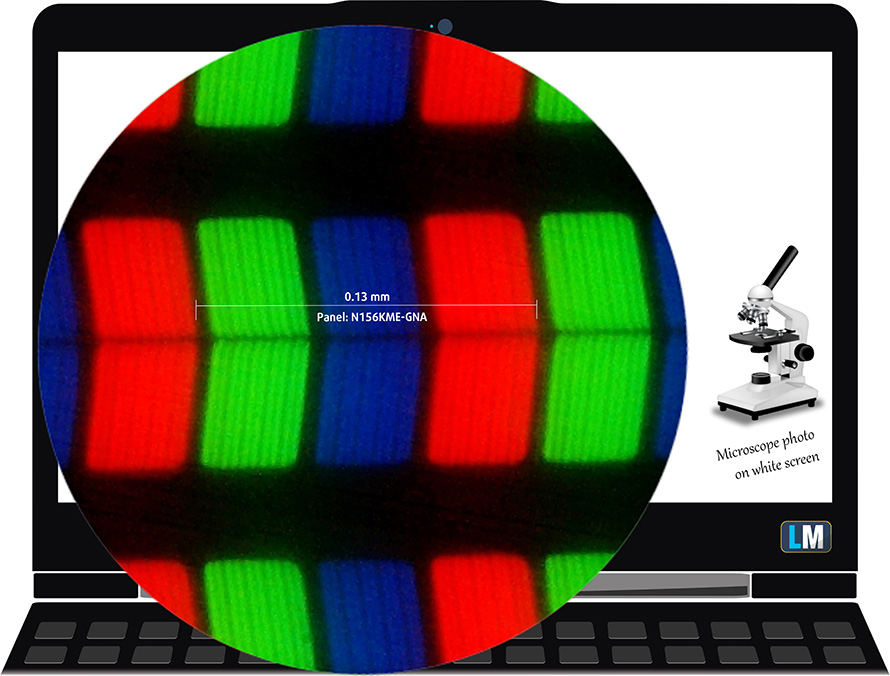
Viewing angles are excellent. We offer images at 45° to evaluate image quality.

Also, a video with locked focus and exposure.
We measured a maximum brightness of 327 nits in the middle of the screen and 329 nits as an average for the whole area, with a maximum deviation of 5%. The Correlated Color Temperature on a white screen is 6490K – matching the optimal for the sRGB standard of 6500K.
In the illustration below you can see how the main display performs from a uniformity perspective. In other words, the leakage of light from the light source.
Values of dE2000 over 4.0 should not occur, and this parameter is one of the first you should check if you intend to use the laptop for color-sensitive work. The contrast ratio is good – 1000:1.
To make sure we are on the same page, we would like to give you a little introduction to the sRGB color gamut and the Adobe RGB. To start, there’s the CIE 1976 Uniform Chromaticity Diagram that represents the visible specter of colors by the human eye, giving you a better perception of the color gamut coverage and the color accuracy.
Inside the black triangle, you will see the standard color gamut (sRGB) that is being used by millions of people on HDTV and on the web. As for the Adobe RGB, this is used in professional cameras, monitors, etc for printing. Basically, colors inside the black triangle are used by everyone and this is the essential part of the color quality and color accuracy of a mainstream notebook.
Still, we’ve included other color spaces like the famous DCI-P3 standard used by movie studios, as well as the digital UHD Rec.2020 standard. Rec.2020, however, is still a thing of the future and it’s difficult for today’s displays to cover that well. We’ve also included the so-called Michael Pointer gamut, or Pointer’s gamut, which represents the colors that naturally occur around us every day.
The yellow dotted line shows ASUS ROG Strix G15 G513R (2022)’s color gamut coverage.
Its display covers 100% of the sRGB/ITU-R BT.709 (web/HDTV standard) in CIE1976, and 98% of the DCI-P3 color gamut, resulting in a vibrant and punchy image.
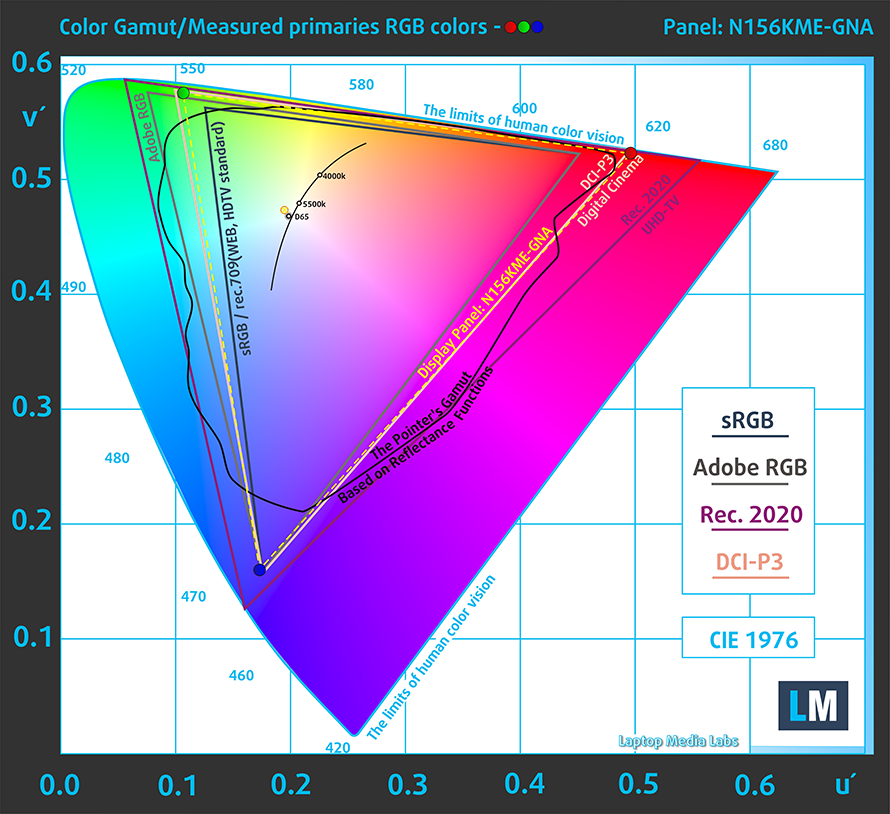
Our “Design and Gaming” profile delivers optimal color temperature (6500K) at 140 cd/m2 luminance and sRGB gamma mode.
We tested the accuracy of the display with 24 commonly used colors like light and dark human skin, blue sky, green grass, orange, etc. You can check out the results in factory condition and also, with the “Design and Gaming” profile.
Below you can compare the scores of ASUS ROG Strix G15 G513R (2022) with the default settings (left), and with the “Gaming and Web design” profile (right).
We also compare the scores of ASUS ROG Strix G15 G513R (2022) with the default settings (left), and with the “Gaming and Web design” profile (right) against the P3-D65 color space.
The next figure shows how well the display is able to reproduce really dark parts of an image, which is essential when watching movies or playing games in low ambient light.
The left side of the image represents the display with stock settings, while the right one is with the “Gaming and Web Design” profile activated. On the horizontal axis, you will find the grayscale, and on the vertical axis – the luminance of the display. On the two graphs below you can easily check for yourself how your display handles the darkest nuances but keep in mind that this also depends on the settings of your current display, the calibration, the viewing angle, and the surrounding light conditions.
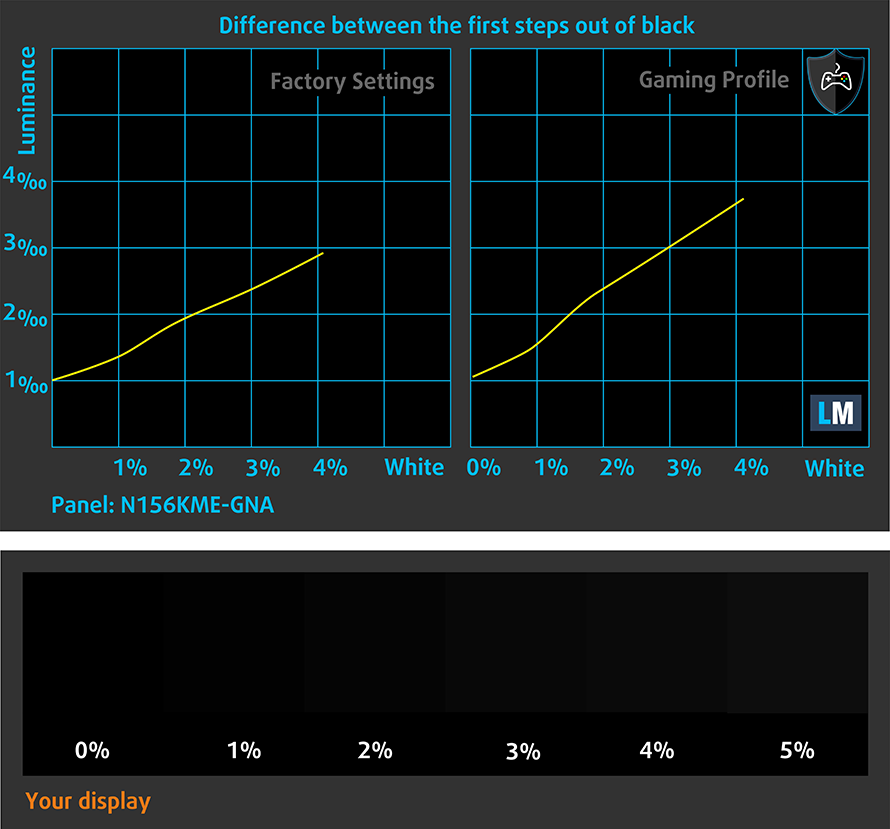
Response time (Gaming capabilities)
We test the reaction time of the pixels with the usual “black-to-white” and “white-to-black” method from 10% to 90% and vice versa.
We recorded Fall Time + Rise Time = 9 ms.
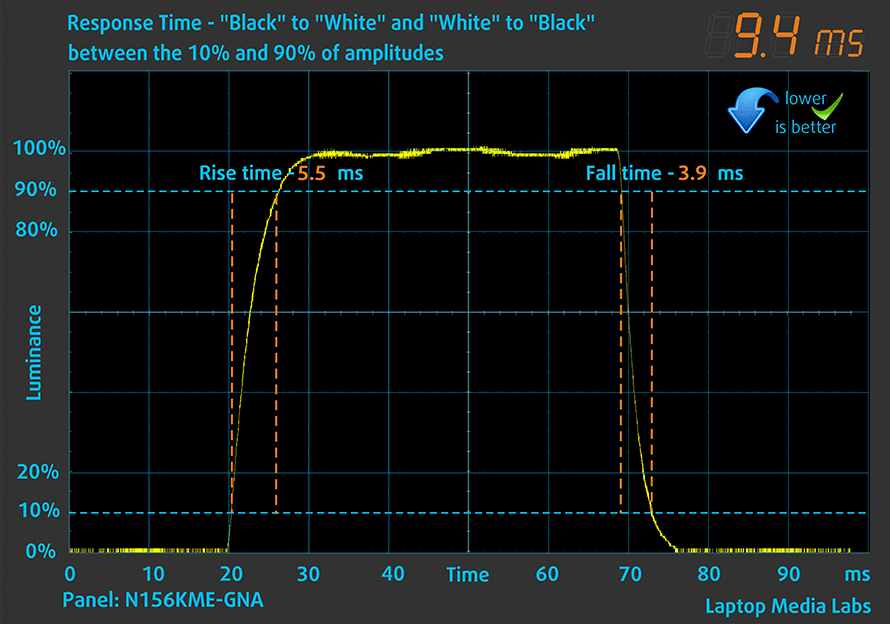
After that, we test the reaction time of the pixels with the usual “Gray-to-Gray” method from 50% White to 80% White and vice versa between 10% and 90% of the amplitude.
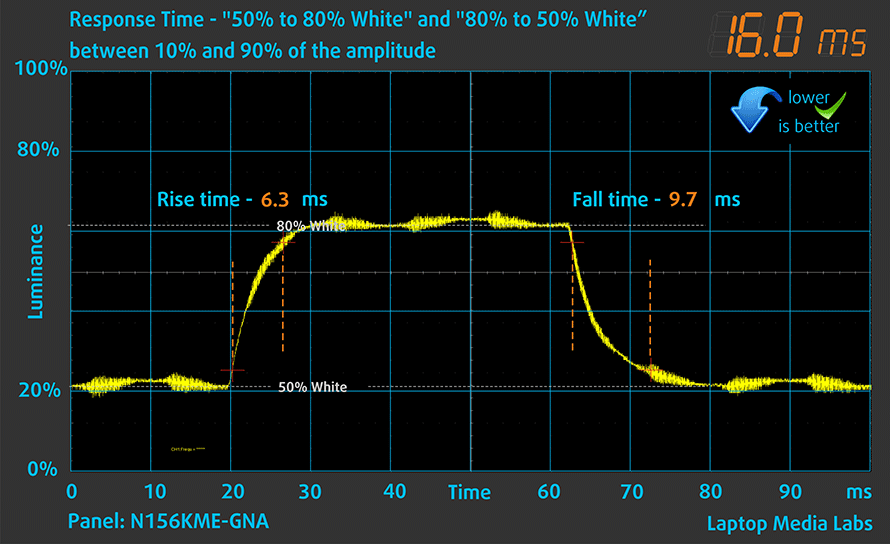
PWM (Screen flickering)
Pulse-width modulation (PWM) is an easy way to control monitor brightness. When you lower the brightness, the light intensity of the backlight is not lowered, but instead turned off and on by the electronics with a frequency indistinguishable to the human eye. In these light impulses, the light/no-light time ratio varies, while brightness remains unchanged, which is harmful to your eyes. You can read more about that in our dedicated article on PWM.
ASUS ROG Strix G15 G513R (2022)’s display doesn’t use PWM to adjust its brightness at any point. This means it is comfortable for long gaming sessions without harming your eyes in this aspect.
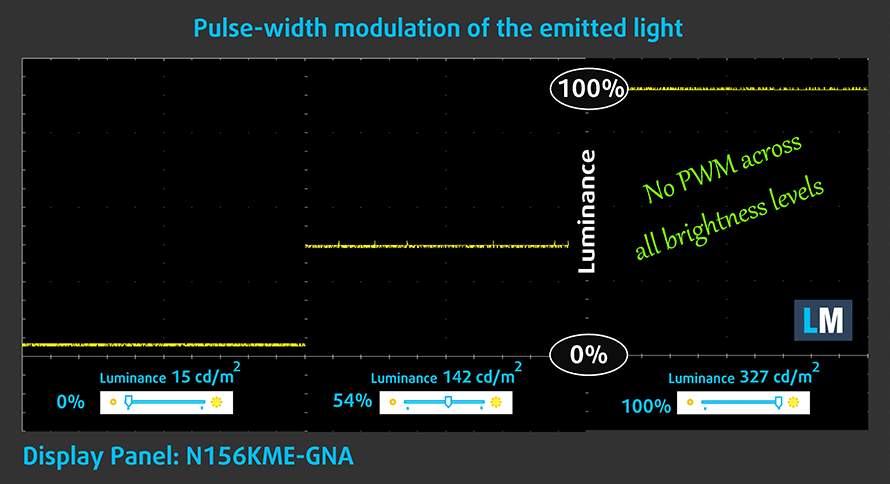
Blue light emissions
Installing our Health-Guard profile not only eliminates PWM but also reduces the harmful Blue Light emissions while keeping the colors of the screen perceptually accurate. If you’re not familiar with the Blue light, the TL;DR version is – emissions that negatively affect your eyes, skin, and your whole body. You can find more information about that in our dedicated article on Blue Light.
Buy our profiles
Since our profiles are tailored for each individual display model, this article and its respective profile package are meant for ASUS ROG Strix G15 G513R (2022) configurations with 15.6″ QHD IPS Innolux N156KME-GNA (CMN1540).
*Should you have problems with downloading the purchased file, try using a different browser to open the link you’ll receive via e-mail. If the download target is a .php file instead of an archive, change the file extension to .zip or contact us at [email protected].
Read more about the profiles HERE.
In addition to receiving efficient and health-friendly profiles, by buying LaptopMedia's products you also support the development of our labs, where we test devices in order to produce the most objective reviews possible.

Office Work
Office Work should be used mostly by users who spend most of the time looking at pieces of text, tables or just surfing. This profile aims to deliver better distinctness and clarity by keeping a flat gamma curve (2.20), native color temperature and perceptually accurate colors.

Design and Gaming
This profile is aimed at designers who work with colors professionally, and for games and movies as well. Design and Gaming takes display panels to their limits, making them as accurate as possible in the sRGB IEC61966-2-1 standard for Web and HDTV, at white point D65.

Health-Guard
Health-Guard eliminates the harmful Pulse-Width Modulation (PWM) and reduces the negative Blue Light which affects our eyes and body. Since it’s custom tailored for every panel, it manages to keep the colors perceptually accurate. Health-Guard simulates paper so the pressure on the eyes is greatly reduced.
Get all 3 profiles with 33% discount
Sound
ASUS ROG Strix G15 G513R (2022)’s speakers produce a sound of very good quality and support Dolby Atmos. Its low, mid, and high tones are clear of deviations.
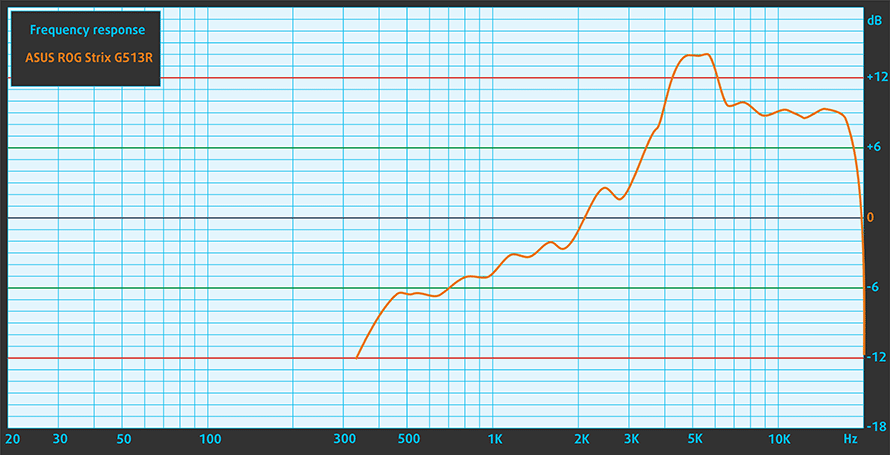
Drivers
All drivers and utilities for this notebook can be found here: https://rog.asus.com/laptops/rog-strix/rog-strix-g15-2022-series/helpdesk_download
Battery
Now, we conduct the battery tests with the Windows Better performance setting turned on, screen brightness adjusted to 120 nits, and all other programs turned off except for the one we are testing the notebook with. This laptop’s 90Wh battery lasts for 11 hours and 3 minutes of Web browsing, or 8 hours and 13 minutes of video playback.
In order to simulate real-life conditions, we used our own script for automatic web browsing through over 70 websites.
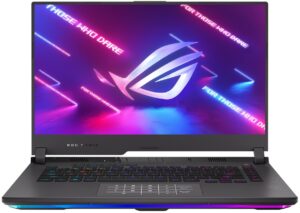
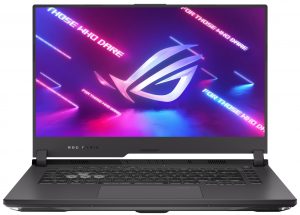
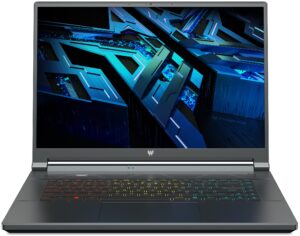



For every test like this, we use the same video in HD.






CPU options
This device sports the brand new Ryzen 7 6800H and Ryzen 9 6900HX CPUs. They are built on a 6nm node and the Zen 3+ architecture. The major change over the last generation is the inclusion of an RDNA2 iGPU.
Results are from the Cinebench R23 CPU test (the higher the score, the better)
Results are from our Photoshop benchmark test (the lower the score, the better)
ASUS ROG Strix G15 G513R (2022) CPU variants
Here you can see an approximate comparison between the CPUs that can be found in the ASUS ROG Strix G15 G513R (2022) models on the market. This way you can decide for yourself which ASUS ROG Strix G15 G513R (2022) model is the best bang for your buck.
Note: The chart shows the cheapest different CPU configurations so you should check what the other specifications of these laptops are by clicking on the laptop’s name / CPU.
Results are from the Cinebench R23 CPU test (the higher the score, the better)
Results are from our Photoshop benchmark test (the lower the score, the better)
GPU options
In terms of graphcis, you get plenty of choice. The options include the RTX 3050 (95W) 4GB, RTX 3060 (140W) 6GB, RTX 3070 Ti (150W) 8GB, RTX 3080 (150W) 8GB, and RTX 3080 Ti (150W) 16GB.
Results are from the 3DMark: Time Spy (Graphics) benchmark (higher the score, the better)
Results are from the 3DMark: Fire Strike (Graphics) benchmark (higher the score, the better)
Results are from the Unigine Superposition benchmark (higher the score, the better)
ASUS ROG Strix G15 G513R (2022) GPU variants
Here you can see an approximate comparison between the GPUs that can be found in the ASUS ROG Strix G15 G513R (2022) models on the market. This way you can decide for yourself which ASUS ROG Strix G15 G513R (2022) model is the best bang for your buck.
Note: The chart shows the cheapest different GPU configurations so you should check what the other specifications of these laptops are by clicking on the laptop’s name / GPU.
Results are from the 3DMark: Time Spy (Graphics) benchmark (higher the score, the better)
Results are from the 3DMark: Fire Strike (Graphics) benchmark (higher the score, the better)
Results are from the 3DMark: Wild Life (Graphics) benchmark (higher the score, the better)
Results are from the Unigine Superposition benchmark (higher the score, the better)
Gaming tests
| Metro Exodus | Full HD, Low (Check settings) | Full HD, High (Check settings) | Full HD, Extreme (Check settings) |
|---|---|---|---|
| Average FPS | 147 fps | 75 fps | 36 fps |
| Borderlands 3 | Full HD, Medium (Check settings) | Full HD, High (Check settings) | Full HD, Badass (Check settings) |
|---|---|---|---|
| Average fps | 115 fps | 95 fps | 78 fps |

| Tom Clancy’s Ghost Recon Wildlands | Full HD, High (Check settings) | Full HD, Very High (Check settings) | Full HD, Ultra (Check settings) |
|---|---|---|---|
| Average | 116 fps | 101 fps | 64 fps |

| Shadow of the Tomb Raider (2018) | Full HD, Medium (Check settings) | Full HD, High (Check settings) | Full HD, Highest (Check settings) |
|---|---|---|---|
| Average | 130 fps | 124 fps | 80 fps |
Temperatures and comfort
Max CPU load
In this test we use 100% on the CPU cores, monitoring their frequencies and chip temperature. The first column shows a computer’s reaction to a short load (2-10 seconds), the second column simulates a serious task (between 15 and 30 seconds), and the third column is a good indicator of how good the laptop is for long loads such as video rendering.
Average core frequency (base frequency + X); CPU temp.
| AMD Ryzen 7 6800H (45W TDP) | 0:02 – 0:10 sec | 0:15 – 0:30 sec | 10:00 – 15:00 min |
|---|---|---|---|
| ASUS ROG Strix G15 G513R (2022) | 3.80 GHz (B+19%) @ 78°C @ 79W | 3.76 GHz (B+18%) @ 84°C @ 78W | 3.78 GHz (B+18%) @ 82°C @ 78W |
Since this is the first laptop with this CPU, we don’t really have anything to compare it to. However, we are pretty positive, that the 3.80 GHz clock speed it is able to sustain is remarkable, especially, considering it never got warmer than 84°C. The liquid metal does its job perfectly.
Real-life gaming
| NVIDIA GeForce RTX 3060 | GPU frequency/ Core temp (after 2 min) | GPU frequency/ Core temp (after 30 min) | Max Fans |
|---|---|---|---|
| ASUS ROG Strix G15 G513R (2022) | 1844 MHz @ 81°C @ 139W | 1723 MHz @ 74°C @ 118W | – |
| ASUS TUF Gaming F17 (FX706, 2021) | 1548 MHz @ 80°C @ 95W | 1540 MHz @ 81°C @ 95W | – |
| HP Omen 17 (2021, 17-ck0000) | 1861 MHz @ 72°C @ 129W | 1857 MHz @ 73°C @ 130W | – |
| Lenovo ThinkBook 16p Gen 2 | 1535 MHz @ 69°C @ 75W | 1517 MHz @ 76°C @ 75W | – |
| Lenovo Legion 5i (17″ Intel, 2021) | 1886 MHz @ 75°C @ 127W | 1879 MHz @ 76°C @ 127W | – |
| Lenovo Legion 7 (16″, 2021) | 1867 MHz @ 70°C @ 126W | 1858 MHz @ 74°C @ 127W | – |
| Lenovo Legion 5 (15″ AMD, 2021) | 1831 MHz @ 75°C @ 129W | 1815 MHz @ 80°C @ 129W | – |
| Lenovo Legion 5 Pro (16″) | 1803 MHz @ 76°C @ 129W | 1787 MHz @ 81°C @ 129W | – |
| MSI GP66 Leopard | 1863 MHz @ 72°C @ 124W | 1852 MHz @ 75°C @ 125W | 1849 MHz @ 69°C @ 127W |
| MSI GP76 Leopard | 1860 MHz @ 71°C @ 129W | 1857 MHz @ 73°C @ 128W | 1869 MHz @ 67°C @ 128W |
The situation on the GPU front looks a bit different. See the 140W TGP comprises two values – the base TGP of the card, plus a Dynamic Boost. In this case, the ratio is 115W to 25W. Usually, we see that most laptops are able to sustain their combined TGP for long periods of time. However, after around two minutes of gameplay, the Dynamic Boost leaves the room like a pregnant woman on her third bathroom break during a family dinner. We think that the firmware is to blame, and a future update can fix the issue, as the GPU was definitely not running too hot in our opinion.
Gaming comfort
Although the laptop was pretty loud during gameplay, we have definitely experienced louder units. ASUS has clearly done a good job with their fan design. Also, the hotspot of the keyboard was really not that hot, while the WASD area remained pretty cool.
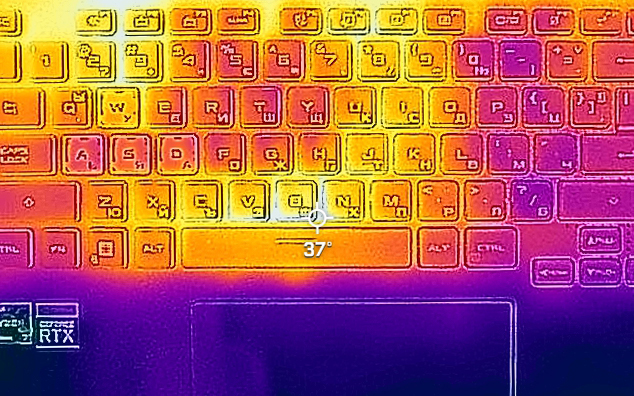
Verdict
 It is good to see that ASUS hasn’t gone the easy route and just put a new CPU inside their old laptop. Instead, you now have Wi-Fi 6E for a more stable wireless connection, while the Ethernet port supports 2.5 Gigabit speeds.
It is good to see that ASUS hasn’t gone the easy route and just put a new CPU inside their old laptop. Instead, you now have Wi-Fi 6E for a more stable wireless connection, while the Ethernet port supports 2.5 Gigabit speeds.
In addition to that, the laptop still offers a good battery life. Well, good is really an understatement, given the fact that this is a gaming notebook. We are talking about 11 hours of Web browsing or more than 8 hours of video playback.
A huge contributor to that is the Adaptive-Sync technology. It means that it runs at 60Hz when high speeds are not needed, and boosts to the full 165Hz when you can take advantage of that.
Speaking of the display, ASUS ROG Strix G15 G513R (2022)’s IPS panel (Innolux N156KME-GNA (CMN1540)) has a QHD resolution, comfortable viewing angles, and a good contrast ratio. What is even more impressive, is that it covers 99% of the sRGB color gamut, which makes the image look really attractive. With a little help from our Gaming and Web design profile, its color representation gets really accurate, which makes the laptop appropriate for professional work. However, this is a gaming device more than anything, and the 165Hz refresh rate is paired with a very fast pixel response time. And for those who want to go the extra mile – the display supports HDR and does not use PWM for brightness adjustment.
Another feature that shouldn’t be overlooked is the MUX switch. Most laptops don’t have one, and even though they come with a discrete GPU, all of the rendered frames need to pass through the integrated graphics card, which is a big bottleneck – especially at high fps. The MUX switch, respectively, allows the dGPU to connect directly to the display, unlocking every single bit of performance.
This is an area, where the laptop doesn’t fall short. Its Ryzen 6000H CPU runs as hard as it can (yet it was bested by Intel’s latest and greatest). We can’t wait to see the Core i7-12700H bathed in liquid metal and placed inside an ASUS device, where it can be properly cooled.
By the way, another improvement for this year’s ROG Strix G15 is the addition of a second USB Type-C 3.2 (Gen. 2) port, and the move to Gen 4 SSDs for the two M.2 PCIe x4 slots on the inside.
All in all, we are happy with what we got, and something as simple as a BIOS/Firmware update will let you extract the true maximum out of this machine. This, combined with the optional 100W power brick, and the long battery life, make the ROG Strix G15 G513R a hotshot for gamers on the go.
You can check the prices and configurations in our Specs System: https://laptopmedia.com/series/asus-rog-strix-g15-g513-2022/
Pros
- Ryzen 6000H CPUs with liquid metal thermal compound
- 2x SODIMM + 2x M.2 PCIe x4 Gen 4 slots
- Wi-Fi 6E + 2.5G LAN port
- Covers 98% of the DCI-P3 color gamut and has accurate color representation with our Gaming and Web design profile (Innolux N156KME-GNA)
- 165Hz panel with quick response times and Adaptive-Sync (Innolux N156KME-GNA)
- PWM-free (Innolux N156KME-GNA)
- RGB all around the place
- Very good battery life
Cons
- Small Arrow keys
- No SD card slot and Thunderbolt support
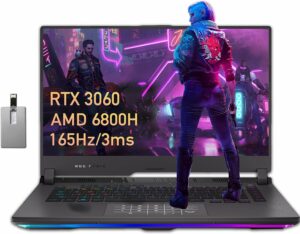


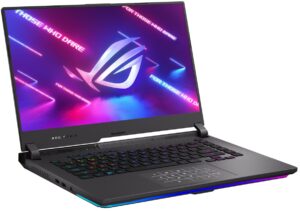
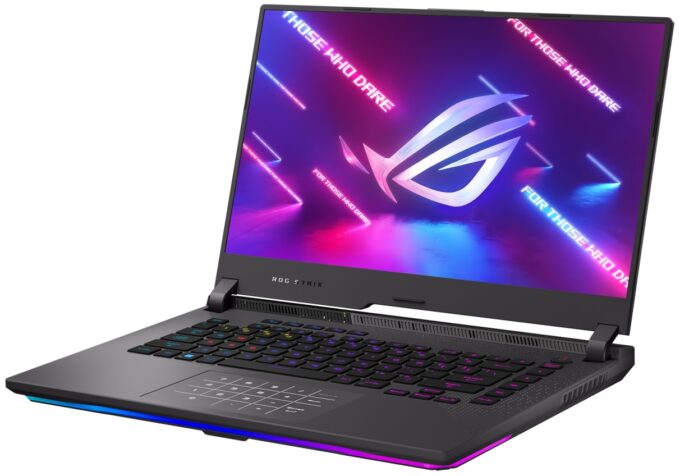
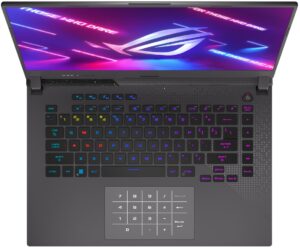
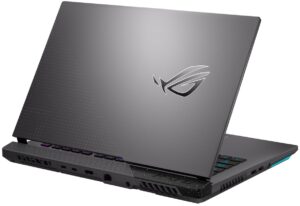
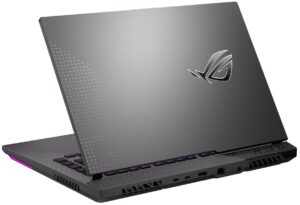

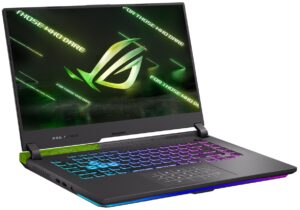
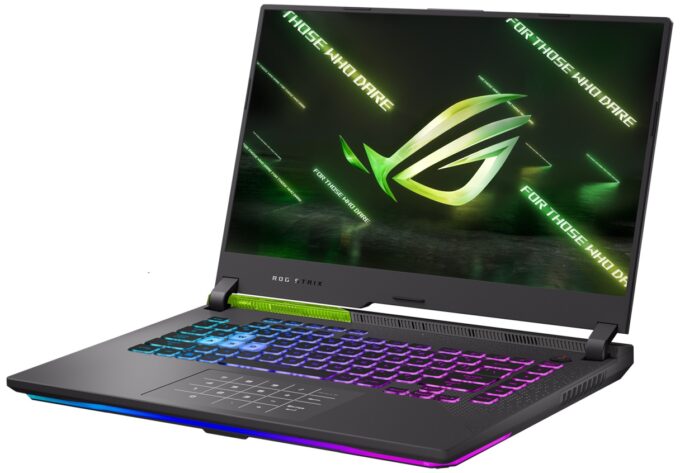
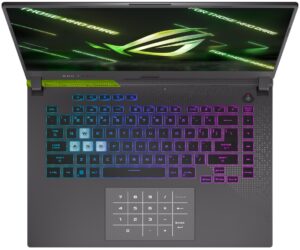
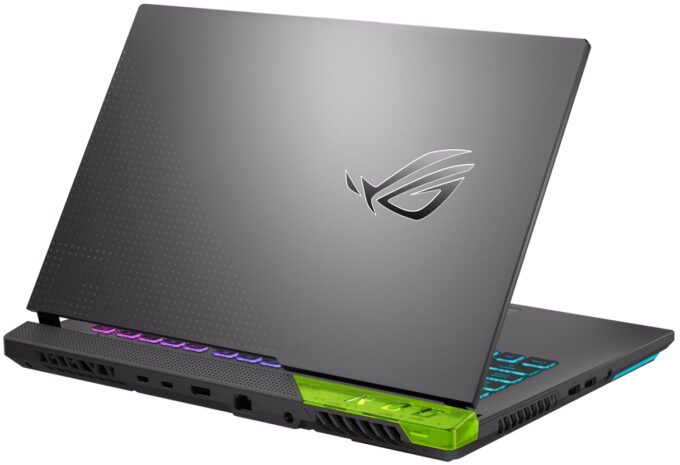
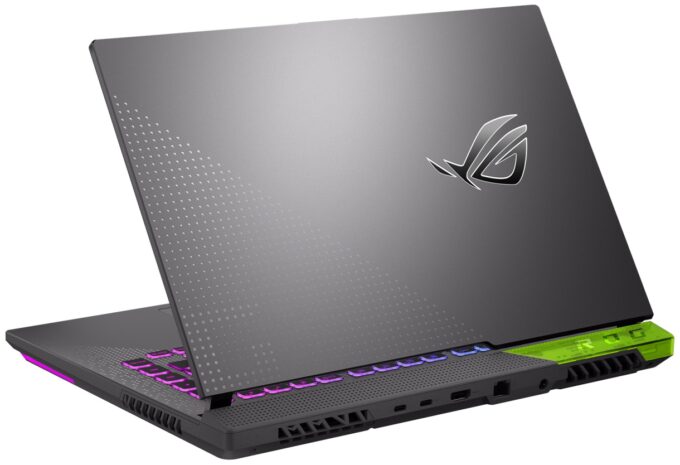
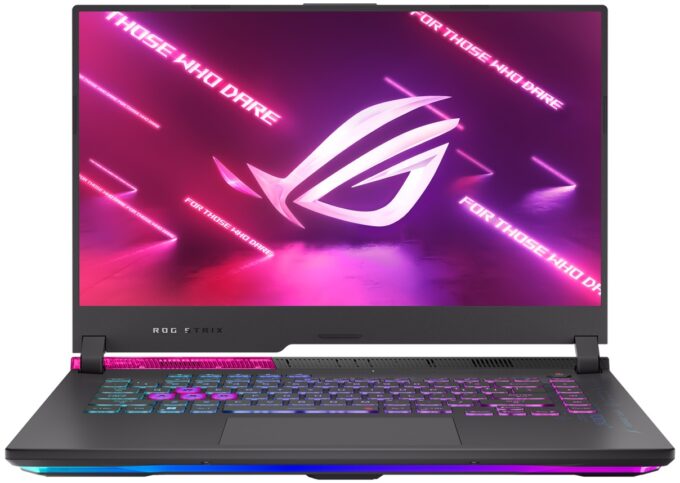
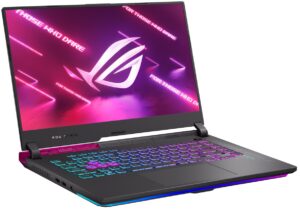
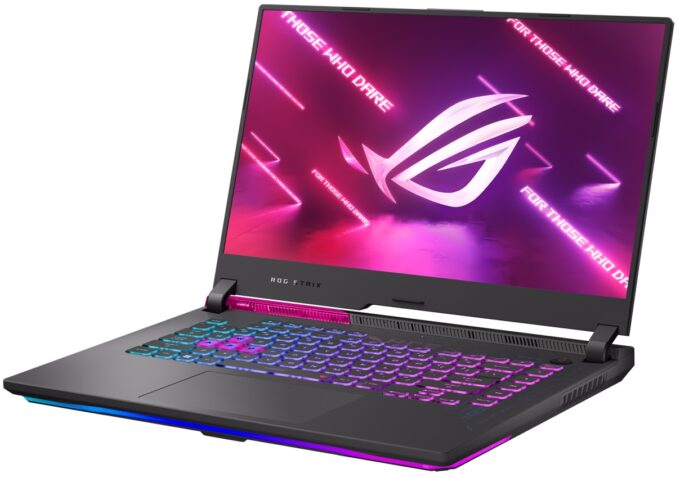


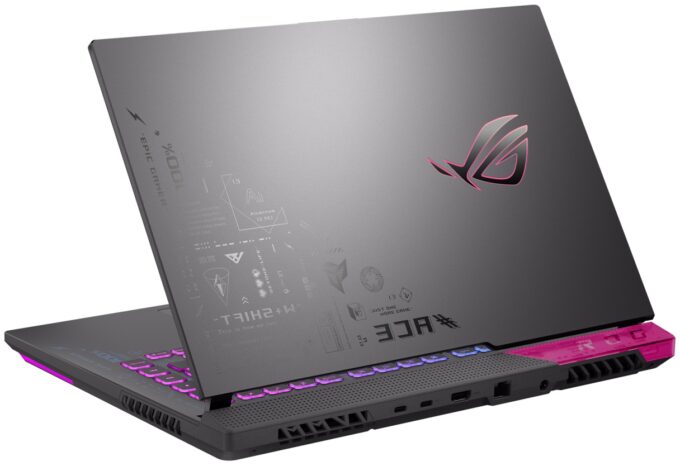




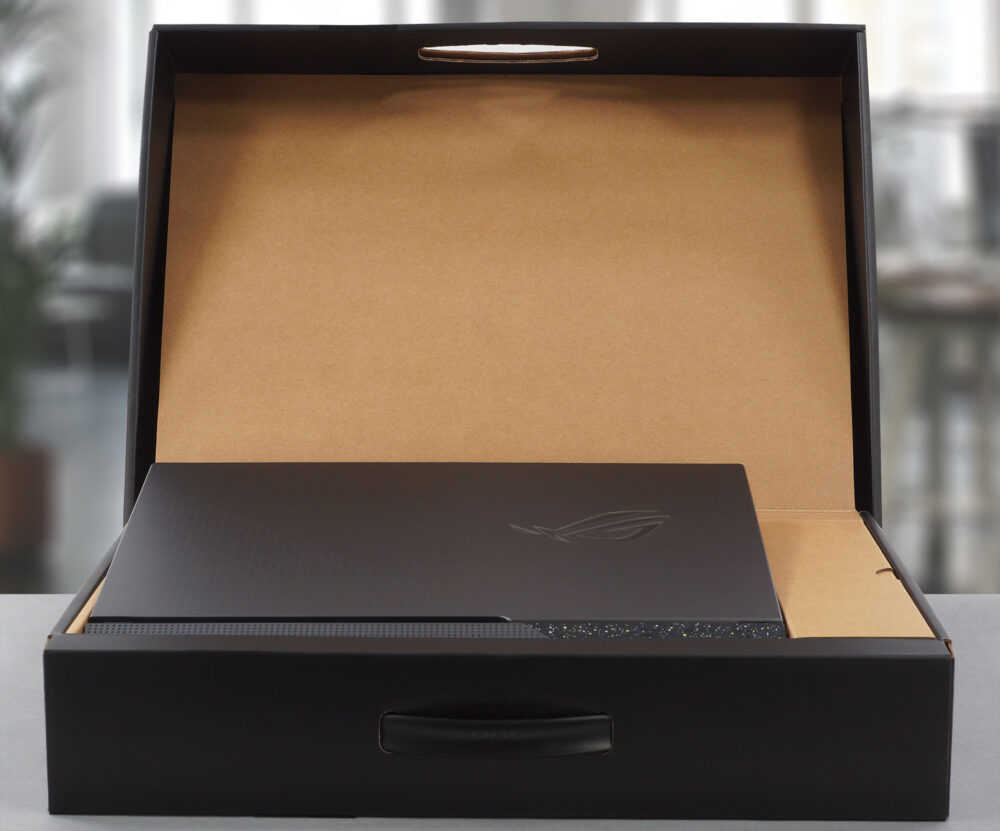
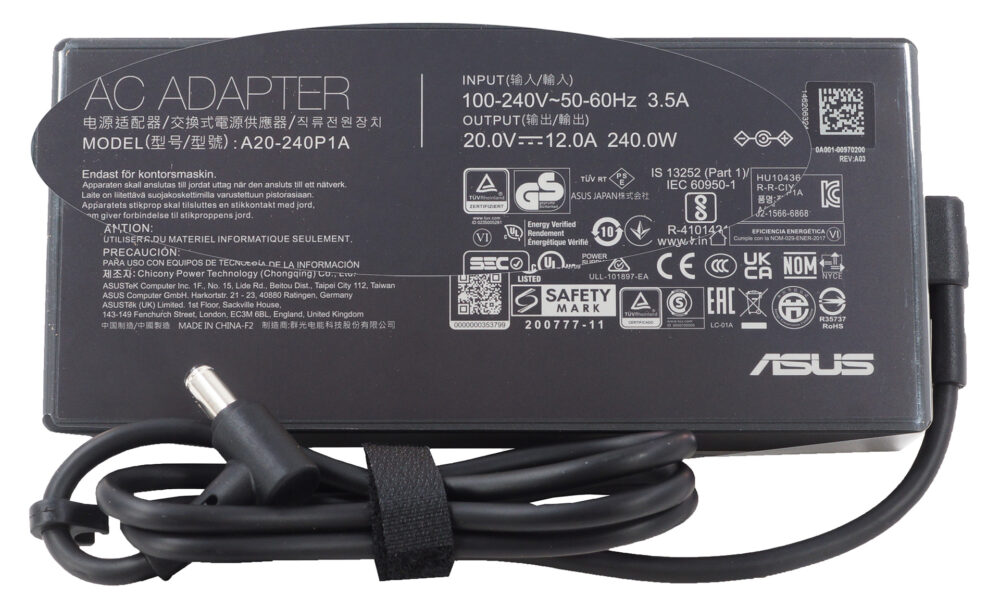

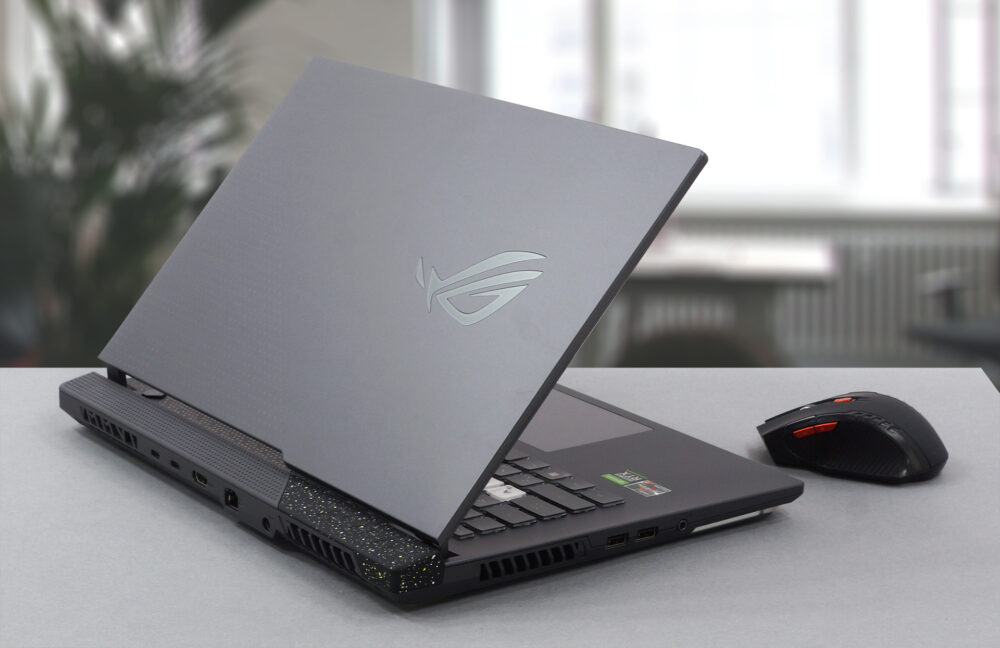
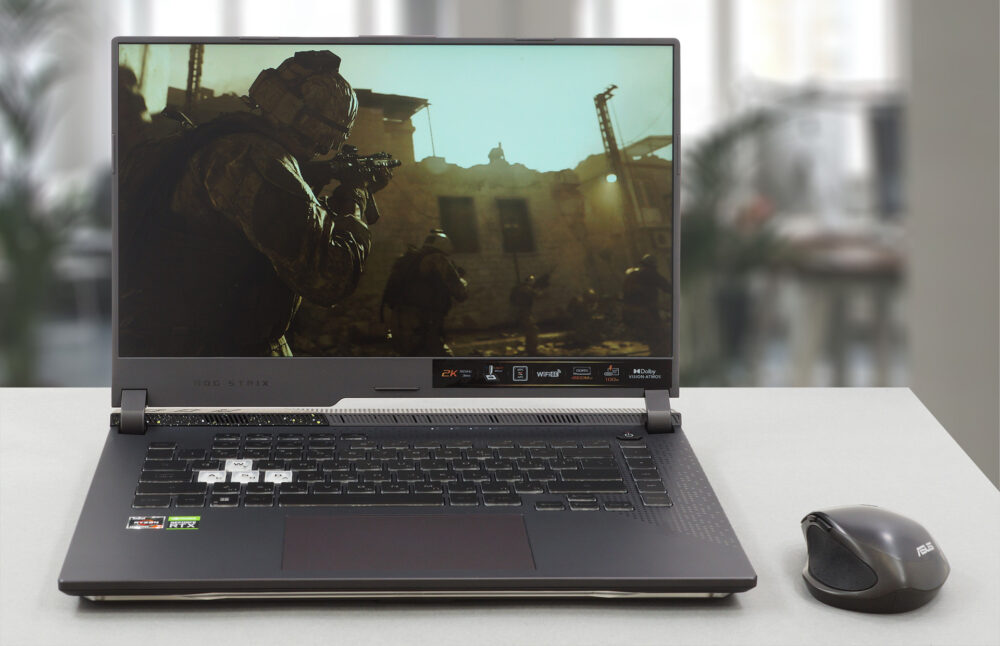
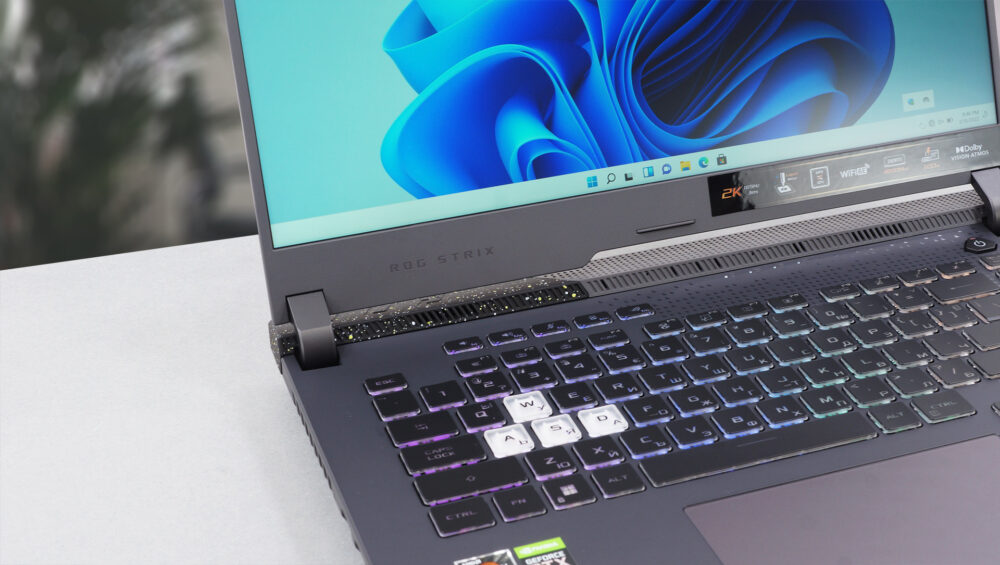
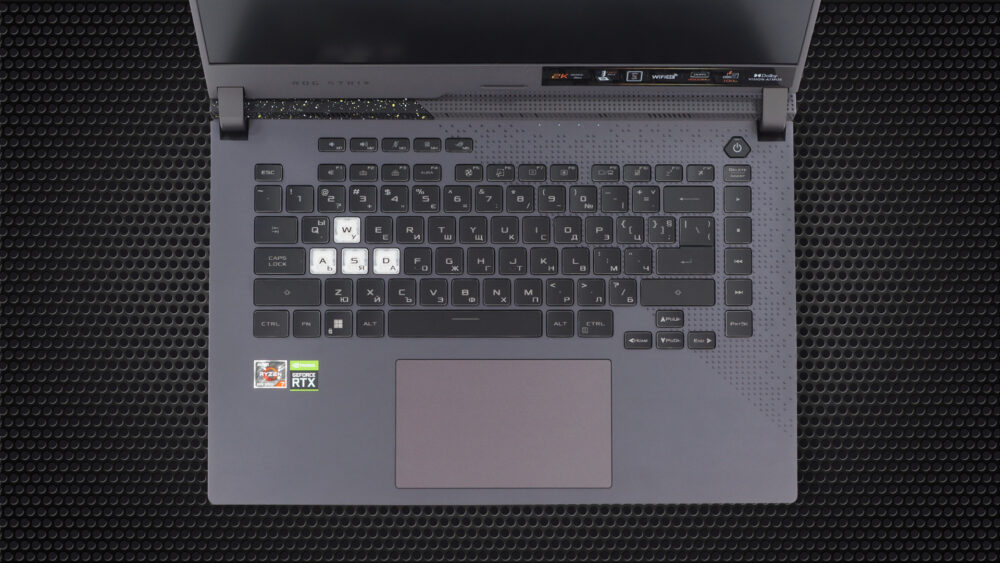
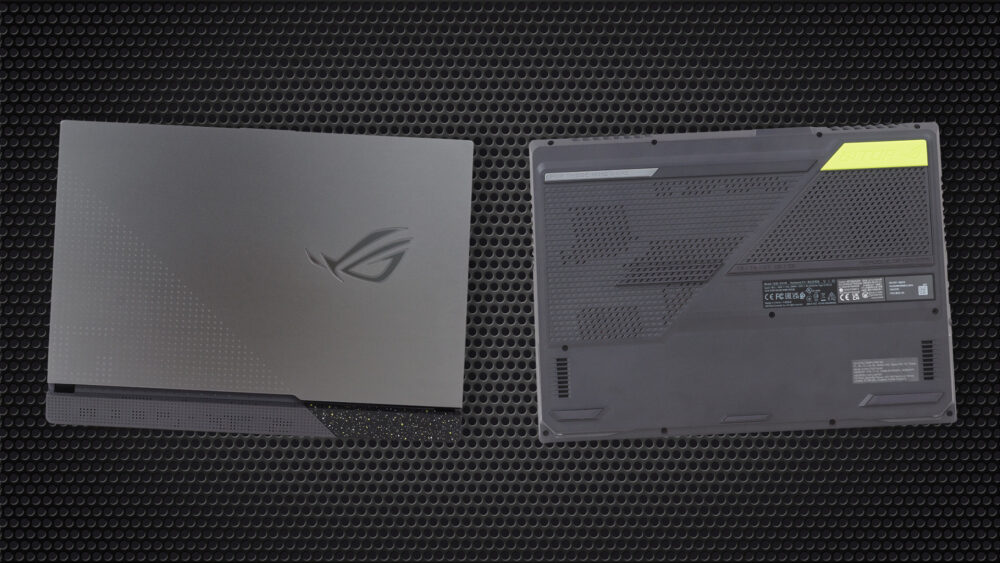






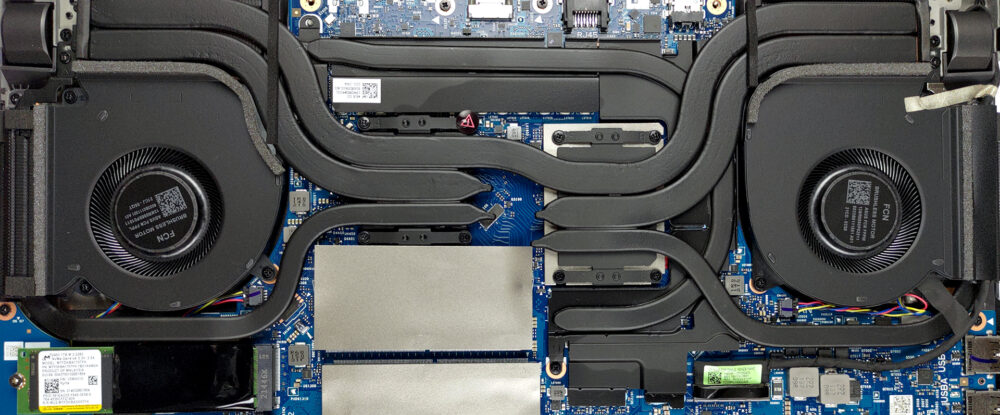

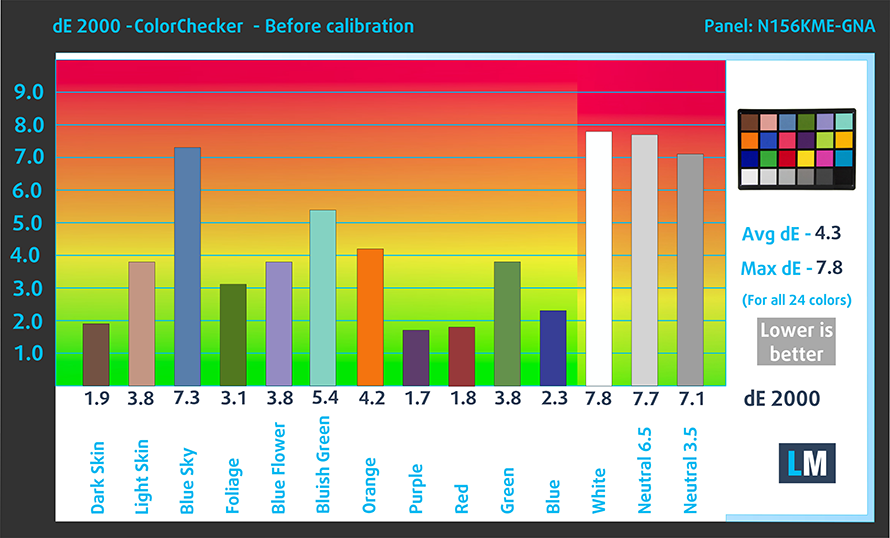


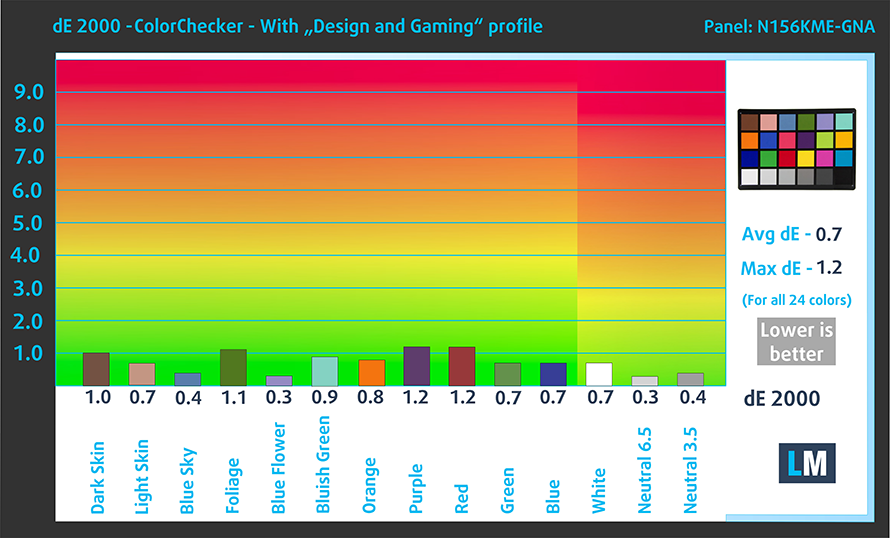


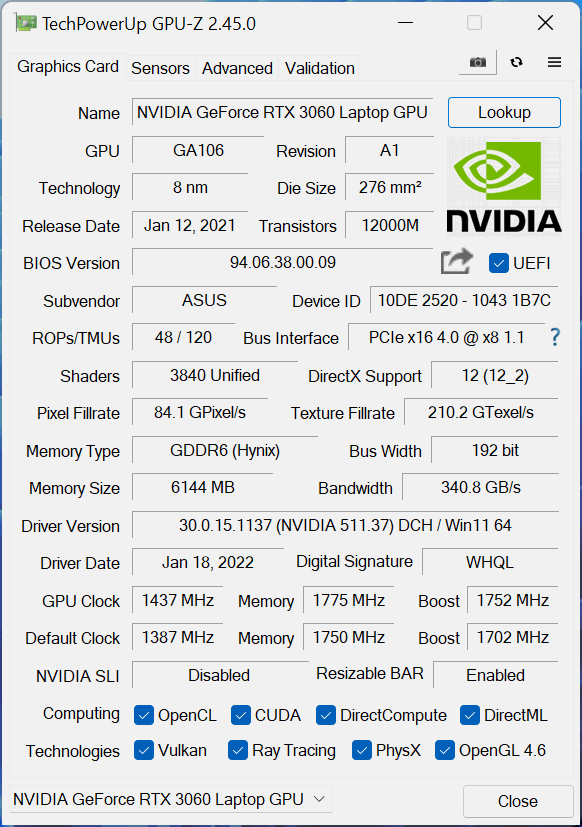









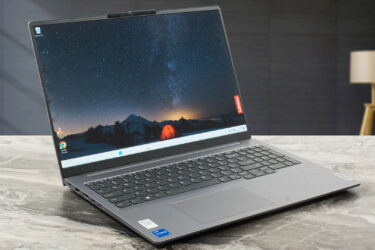
Hola! el touchpad no funciona como teclado numerico? en las imagenes parece que tiene la opcion pero en ningun sitio lo menciona